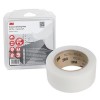How to remove adhesive tape from aluminium. All the necessary steps
How can you remove adhesive tape from aluminium? There are bicyclists who wonder about how to effectively remove adhesive tape from their bicycle frames after they have undergone a repainting process.
But there are also people who ask this question because they have aluminium window frames, or shutters. Not to mention people who wish to remove the adhesive tape from the aluminium surface of shelves and other professional furniture, where they had hung schedules, calendars, notices, and so on.
Aluminium is in fact a material used in many different industries, for the most disparate purposes, and is therefore present in many different forms in our daily lives.
To effectively remove adhesive tape from aluminium, as we will outline shortly, it is best to follow the basic advice given for the removal of adhesive tape glue from any metal surface: let’s have a look at what they are!
How to remove adhesive tape from aluminium: what not to do
There is really only one thing that we absolutely recommend you avoid doing when removing double-sided tape from aluminium, which is using tools which could scratch its surface. Scratching the affected surface with metal brushes, however hard it might be, is therefore not a viable option.
But that’s not all: when dealing with painted aluminium surfaces it is best to also avoid using overly aggressive solvents, which could melt or ruin the paint.
Much better, then, to try other methods first, and resort to solvent only when you are sure that that particular type of solvent won’t cause any side effects when used on painted metal surfaces.
How to remove adhesive tape from aluminium: what to do
So, let’s figure out how to remove adhesive tape from aluminium effectively, quickly, and without any risk. Where to start?
The first and fastest technique consists in taking a hair dryer and pointing it towards the adhesive tape to be removed. The heat, in fact, makes the tape’s glue softer, and therefore more pliant.
It is no coincidence that, in bodywork projects, workers often use special professional heat guns to remove adhesive! Heat the adhesive tape with a hair dryer, starting from one end, and after a few seconds try to lift a flap.
You can help yourself with a plastic scraper, which makes it possible to push up from under the industrial double-sided adhesive without damaging the aluminium. The ideal tool in this sense is the kind of scraper used during the winter season to remove layers of ice from the windshields of cars: combining this scraper with the heat of the hair dryer should be enough to lift at least one flap of the tape quite easily, allowing you, then to pull the tape vigorously.
When a plastic scraper isn’t available, you can also use a plastic card, such as an old gym or library card.
So far there should be no particular issues. In the case of old double-sided adhesive tape, having been applied on surfaces a long time ago, you could however have to deal with some pretty stubborn glue residue.
The bottom layer of double-sided adhesive tape, the one made of glue, can at times not detach from the metal surface, but rather from the tape itself. What to do then? You can heat the glue again with a hair dryer, or you can change your technique.
Among the simplest techniques there is certainly one that involves “soaking” the affected surface. Mix some hot water with vinegar and possibly also with a little lemon, and then rub the affected surface first with a cloth, and then with the scraper mentioned above.
In other cases, when the glue is particularly stubborn, you can also try using vegetable oil, which offers a good emollient: olive oil, seed oil, and other oils of this kind are all suitable.
In the same way, unlocking lubricant, or the famous sprays used in mechanical workshops and found in the tool case of every DIY enthusiast can be used to remove glue residue of industrial double-sided adhesive tape from aluminium, with greater care not to get the surface too dirty.
To remove the last of the residue, after these treatments, you can also use, instead of a plastic scraper, even something more effective, but riskier as well. Razor blades, for example, which are to be used with all due care, to avoid cutting yourself or ruining the aluminium.
The trick in this regard is to keep the blades tilted against the aluminium surface, so as not to allow the blade to chip any of it.







